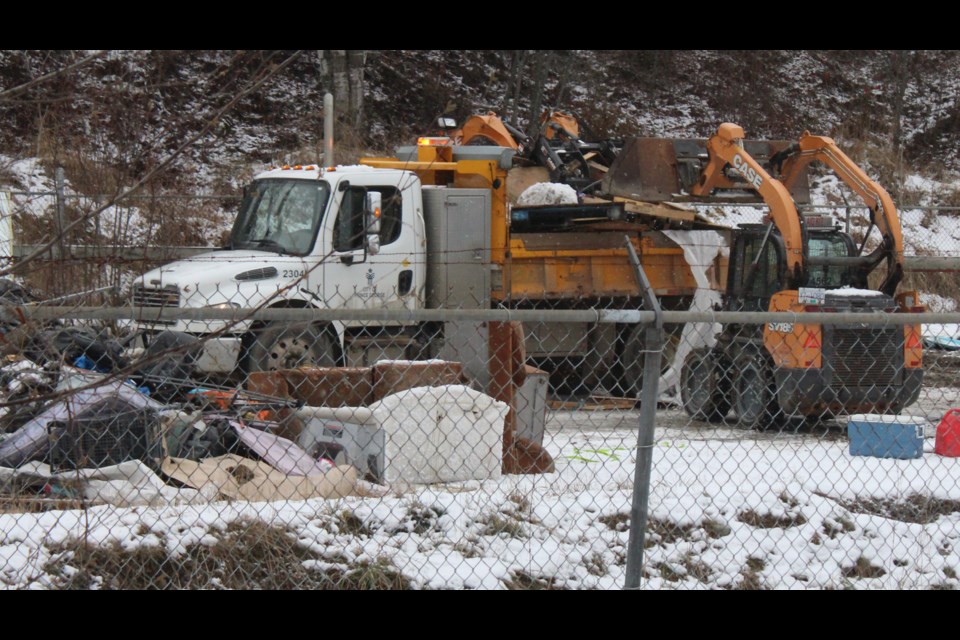Senior city managers spent weeks planning to clear out the Lower Patricia homeless encampment known as Moccasin Flats, in violation of an existing court order, internal emails show.
The emails, obtained by The Citizen from BC Housing and the City of Prince George through a Freedom of Information request, chronicle the lead up to Nov. 17. 2021. On that day, City of Prince George bylaw, parks and solid waste staff used heavy equipment to remove tents, structures and other belongings left by people relocated from the camp, despite the October 25, 2021 court order to leave the location intact until suitable housing and daytime facilities were in place.
On Nov. 3, 2021, the City of Prince George issued a press release celebrating the successful relocation of 20 inhabitants of an encampment located on George Street and pledging to work with BC Housing and other partners to address the Lower Patricia encampment.
On Nov. 4, Chris Bone, the city’s senior manager of strategic initiatives and partnerships, outlined a plan for the Lower Patricia encampment in an email to city manager Walter Babicz and city director of public safety Adam Davey.
Malachy Tohill, northern B.C. regional director of operations for BC Housing, had told her that BC Housing had 19 units available at a shelter in the former Knights Inn downtown, Bone wrote, adding that a count done that day showed only 21 residents at the Lower Patricia encampment.
“As you know, the Lower Patricia encampment has been mapped in zones. BC Housing is proposing that they start with zone one and facilitate the immediate move of campers willing to relocate to the Knights Inn. Those not willing to relocate would be moved to zone two,” Bone wrote. “If this approach is of interest to the City, his question is can we close off zones as they are cleared of campers so no further campers arrive. His concern is that the Knights Inn can only take 19 more, and his staff are already aware that existing shelter accommodation is not of interest to those currently sleeping outside. If BCH clears some individuals and the area vacated is not closed off, there is a risk of more campers arriving expecting that they will be offered access to the Knights Inn which will be at capacity if the proposed approach proceeds.”
Tohill also told her that several tents in the encampment were abandoned, and hadn’t been used in some time, and that his staff would advise city bylaw services manager Charlotte Peters, “where those tents are so they can be removed, and the surrounding area cleaned up.”
On Nov. 5, Bone emailed Tohill to say Davey would be inviting him to a meeting to discuss a plan.
“We followed up with our legal counsel regarding BC Housing’s proposal to begin transitioning individuals from the Lower Patricia encampment to the Knights Inn, on a zone by zone basis. It appears that we have some latitude to move forward with that approach,” Bone wrote.
“Just for clarity, BC housing did not put forward a proposal, (I) was only asking a question, we are looking at as many ideas as possible for a safe and orderly transition from the encampment this is only one idea,” Tohill responded by email to Bone and Davey the following morning.
“Thanks Malachy,” Bone responded, 10 minutes later. “The ‘idea’ was a good one that was well received on our end! There is interest in moving forward.”
‘IMMEDIATELY REMOVE ANY TENTS/MATERIAL LEFT’
An undated meeting invitation indicates Davey set up a meeting involving senior city staff, RCMP Superintendent Shaun Wright and Tohill, to plan “a potential clean-up and consolidation of abandoned tents into fewer zones.”
Davey included a map of the Lower Patricia encampment as of Nov. 4 at 2 p.m. in the meeting invitation, which was provided to the city by BC Housing. The map divided the encampment in four zones, and indicated the location of each tent, structure, vehicle and other facilities, and which were believed to be empty.
According to a legend on the map, there were a total of 32 tents, of which 17 were believed to have been vacant for more than five days or were being used for storage. Twenty-one people were counted onsite, but a total of 28 names and three unknown people were associated with the camp.
“As you may know, there are number of abandoned tents / debris, and we ought to plan to clean this up,” Davey wrote. “Although the injunction process is still ongoing, we believe this is an initial public safety step we can take in the interim.”
In an email to Babicz on the morning of Nov. 16, 2021, a day before city staff moved in, Bone provided the city manager with an update regarding an earlier conversation.
Tohill had informed her that BC Housing would be relocating five people from the Patricia encampment that day, Bone wrote, with more the following day.
“As was the case with the George Street location, those moving will be provided with two totes to pack their belongings,” Bone wrote. “He asked about the ability of Bylaw to immediately remove any materials/tents left by those who are relocating. This will prevent the sale of tents/property to others (who may opt to move to the encampment).”
The Nov. 17 dismantling of structures and removal of material resulted in an immediate legal challenge by the B.C. First Nations Justice Council. Ultimately, on Feb. 23, 2022, B.C. Supreme Court Justice Simon Coval ruled the city had violated the previous court order and had “inflicted serious harm on vulnerable people” in the process.
In March, the City of Prince George ended its court appeals of the rulings and issued a formal apology for the actions taken on Nov. 17, 2021.
Part 2 of this three-part series will examine the city’s response to the public backlash over the demolition of the camp.






